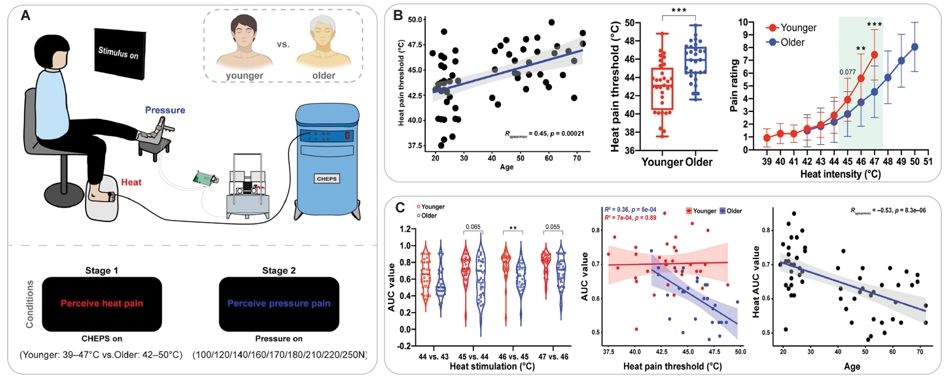Does the perception of pain change with age? In particular, is there a significant increase or decrease in perception between older and younger people in response to different kinds of painful stimuli, such as thermal and pressure?
Pain perception, as a complex physiological and psychological process, is influenced by various factors, including age, gender, cultural background, and previous pain experience. With the population's accelerated aging, understanding how age affects pain perception and how these changes occur is critical for developing appropriate pain management strategies for older adults.
To investigate this issue, Dr. KONG Yazhuo and his team compared the similarities and differences in the perception of two different modalities of stimuli, heat and pressure, between young and older adults by collecting sensory debriefings of these stimuli from young adults and older adults(Figure 1A). This study aims to reveal the behavioral pattern underlying the changes in pain perception during aging and provide a scientific basis for pain management and treatment in older adults.
The study design involved applying heat and pressure stimuli that relied on small and large fibers, respectively, in groups of younger and older adults. Participants' pain threshold, and ratings of stimulus sensation were assessed through heat and pressure pulses of nine intensities applied to their right and left feet separately.
The researchers found older adults reported lower pain ratings for heat stimuli above their pain threshold, indicating a reduced sensitivity to heat pain with age (Figure 1B). Moreover, older adults had significantly lower discriminative ability for thermal stimuli near or above their pain thresholds compared with younger adults, indicating a decline in the ability to discriminate heat pain intensity with age (Figure 1C). However, no significant decrease was observed in pressure pain.
The study concludes that aging is associated with a decline in heat pain perception, evidenced by increased thresholds and reduced discriminability. Interestingly, pressure pain perception and sensitivity do not show significant age-related changes. These findings enhance our understanding of how aging affects somatosensory functioning, which could inform assessments and treatments for older adults experiencing pain.

Figure 1: (A) Experimental setup and conditions (created with BioRender.com). (B) Correlation between age and pain thresholds; Significant difference in heat threshold; Pain ratings of heat stimuli across younger and older groups (**p < 0.01, ***p < 0.001). (C) Significant difference in pain discriminability at various levels of heat stimuli; Correlations between pain discriminability and pain threshold; Correlations between age and discriminability of heat stimulation (**p < 0.01).
The study entitled “Age-associated changes in multimodal pain perception” supported by the National Natural Science Foundation of China, was published online on May 22 in Age And Ageing.
LIU Chen
Institute of Psychology
Chinese Academy of Sciences
Beijing 100101, China.
E-mail: liuc@psych.ac.cn
